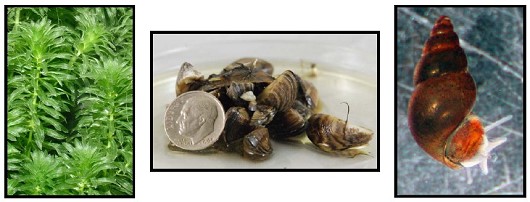Invasive Species

What are invasive species and why are they a problem?
Californians have benefited from the introduction of plant and animal species necessary for food or other human pursuits; however, there are many other introduced species that can wreak havoc on the state’s environment and economy. Those species that cause harm and once established, spread quickly from their point of introduction are often called “invasive.”
Invasive species threaten the diversity or abundance of native species through competition for resources, predation, parasitism, interbreeding with native populations, transmitting diseases, or causing physical or chemical changes to the invaded habitat. Through their impacts on natural ecosystems, agricultural and other developed lands, water delivery and flood protection systems, invasive species may also negatively affect human health and/or the economy. Examples of direct impact to human activities include the clogging of navigable waterways and water delivery systems, weakening flood control structures, damaging crops, introducing diseases to animals that are raised or harvested commercially, and diminishing sportfish populations.
Selected References:
Identifying Risk Factors To Strengthen Current Strategies Aimed At Minimizing The Introduction of Quagga and Zebra Mussels To Lake County, California (.pdf)
Zebra and Quagga Mussels - Changing North America's Freshwater Ecosystems
Addressing the Challenge of Mutual Acceptance of Dreissenid Mussel Vessel Certification Programs
Other Sites of Interest:
Selected References:
Identifying Risk Factors To Strengthen Current Strategies Aimed At Minimizing The Introduction of Quagga and Zebra Mussels To Lake County, California (.pdf)
Zebra and Quagga Mussels - Changing North America's Freshwater Ecosystems
Addressing the Challenge of Mutual Acceptance of Dreissenid Mussel Vessel Certification Programs
Other Sites of Interest:
UCCE Water Agency Eurasian Mussel Action Program (WAEMAP)-
The WAEMAP project was initiated in late 2011 to assist Caifornia water managers in preventing and controlling Eurasian mussel infestations. We provide education and outreach to water and irrigation districts, local and municipal water agencies, and power agencies via this website, publications, and a workshop series.
Quagga & Zebra mussels-
http://www.dfg.ca.gov/invasives/quaggamussel/
New Zealand Mud snails- http://www.dfg.ca.gov/invasives/mudsnail/
CDFA Plant Health and Pest Prevention Services has a variety of information on exotic plant pests and diseases.- http://www.cdfa.ca.gov/phpps/
One invasive plant, hydrilla, that was introduced into Clear Lake in the early 1990s has been under a mandatory CDFA eradication program since 1994.- http://www.cdfa.ca.gov/phpps/ipc/hydrilla/hydrilla_hp.htm
California DFW has a website on nuisance and exotic (not native to CA) wildlife species- http://www.dfg.ca.gov/wildlife/nongame/nuis_exo/
For more information on aquatic species the USGS site on nonindigenous species is the web reference site for the Florida Integrated Science Center, the central repository for non-native aquatic species- http://nas.er.usgs.gov/default.asp
In October 2010 UC hosted a statewide summit addressing the threat of invasive mussels that facilitated a discussion on how the state should consider moving forward to minimize the risk of spreading the mussels to yet unaffected waters. The agenda and presentations are presented here to allow you access to the information. http://ucanr.org/sites/musselsummit/
New Zealand Mud snails- http://www.dfg.ca.gov/invasives/mudsnail/
CDFA Plant Health and Pest Prevention Services has a variety of information on exotic plant pests and diseases.- http://www.cdfa.ca.gov/phpps/
One invasive plant, hydrilla, that was introduced into Clear Lake in the early 1990s has been under a mandatory CDFA eradication program since 1994.- http://www.cdfa.ca.gov/phpps/ipc/hydrilla/hydrilla_hp.htm
California DFW has a website on nuisance and exotic (not native to CA) wildlife species- http://www.dfg.ca.gov/wildlife/nongame/nuis_exo/
For more information on aquatic species the USGS site on nonindigenous species is the web reference site for the Florida Integrated Science Center, the central repository for non-native aquatic species- http://nas.er.usgs.gov/default.asp
In October 2010 UC hosted a statewide summit addressing the threat of invasive mussels that facilitated a discussion on how the state should consider moving forward to minimize the risk of spreading the mussels to yet unaffected waters. The agenda and presentations are presented here to allow you access to the information. http://ucanr.org/sites/musselsummit/

